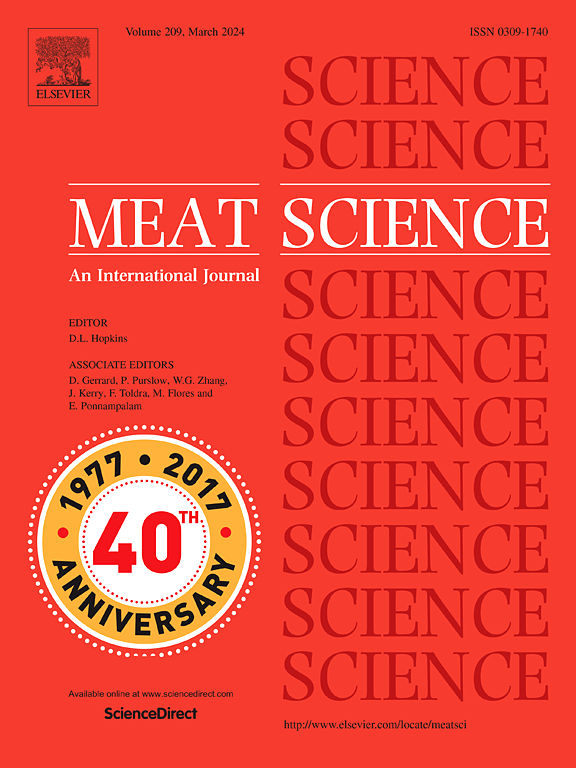迈向猪肉的“一个质量”方法:从农场到餐桌连续体背景下的挑战和机遇的视角-特邀评论
IF 6.1
1区 农林科学
Q1 Agricultural and Biological Sciences
引用次数: 0
摘要
大量关于猪肉生产和消费的研究强调了产品固有的内在品质和与生产方式相关的外在品质之间的相互作用,它们共同有助于对新鲜猪肉的感知和评估。然而,研究强调,很难根据国家、消费者的知识、经验和个人信仰以及它们随时间的动态变化来确定它们的相对重要性。要实现可持续发展目标,确保以有利可图的方式生产健康、营养、公平和环境友好型猪肉,对内在和外在质量维度进行联合和多维考虑至关重要。然而,很少有研究调查了猪肉内在品质和外在品质多个维度之间的协同作用和拮抗作用。该视角旨在定义和推广“一个品质”猪肉的概念,作为满足猪肉价值链中利益相关者的多重和不同期望的方法,同时共同考虑猪肉质量和可持续性。它旨在讨论消费者、公民和包括政策制定者在内的公共行动的不断变化的期望如何促进猪肉质量的整体定义和评估。它还试图探索如何猪肉质量的多个维度,包括其内在和外在的维度,可以同时考虑。然后,在从农场到餐桌的整个过程中,讨论了对猪肉实施“一个质量”方法以对农业系统进行综合可持续性评估的机遇和挑战,即通过共同解决内在质量属性,确保可持续的农业实践,利益相关者的经济可行性,并与消费者和公民的期望保持一致。本文章由计算机程序翻译,如有差异,请以英文原文为准。

Towards a ‘One quality’ approach of pork: A perspective on the challenges and opportunities in the context of the farm-to-fork continuum – Invited review
A substantial amount of research on pork production and consumption highlights an interplay between the intrinsic qualities that are inherent to the product and the extrinsic qualities related to how it is produced, which together contribute to the perception and evaluation of fresh pork. However, studies have emphasised difficulties in defining their relative importance depending on the countries, consumers' knowledge, experience and personal beliefs, as well as their dynamic changes over time. A joint and multidimensional consideration of the intrinsic and extrinsic quality dimensions is critical to achieve sustainable development goals that ensure healthy, nutritious, fair and environmentally friendly pork produced in a profitable manner. However, very few studies have investigated the synergies and antagonisms between the multiple dimensions of intrinsic and extrinsic qualities of pork. This perspective aims to define and promote the concept of ‘One Quality’ pork, as an approach to meeting the multiple and divergent expectations of stakeholders in the pork value chain, while jointly considering pork quality and sustainability. It aims to discuss how the changing expectations of consumers, citizens and public action including policy makers are currently promoting a holistic definition and evaluation of pork quality. It also seeks to explore how the multiple dimensions of pork quality, including their intrinsic and extrinsic dimensions, can be considered simultaneously. The opportunities and challenges of implementing a ‘One Quality’ approach to pork for an integrated sustainability assessment of the farming systems, i.e., by jointly addressing the intrinsic quality attributes, ensuring sustainable farming practices, economic viability for stakeholders, and alignment with consumer and citizen expectations, are then discussed along the farm-to-fork continuum.
求助全文
通过发布文献求助,成功后即可免费获取论文全文。
去求助
来源期刊

Meat Science
工程技术-食品科技
CiteScore
12.60
自引率
9.90%
发文量
282
审稿时长
60 days
期刊介绍:
The aim of Meat Science is to serve as a suitable platform for the dissemination of interdisciplinary and international knowledge on all factors influencing the properties of meat. While the journal primarily focuses on the flesh of mammals, contributions related to poultry will be considered if they enhance the overall understanding of the relationship between muscle nature and meat quality post mortem. Additionally, papers on large birds (e.g., emus, ostriches) as well as wild-captured mammals and crocodiles will be welcomed.
 求助内容:
求助内容: 应助结果提醒方式:
应助结果提醒方式:


